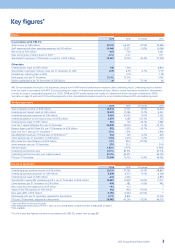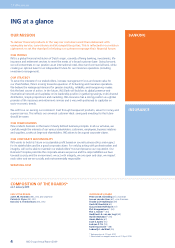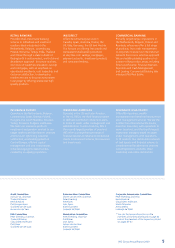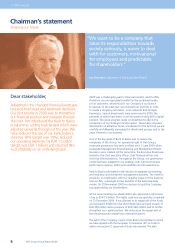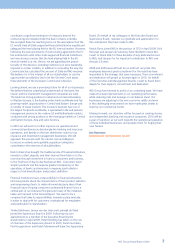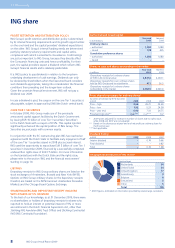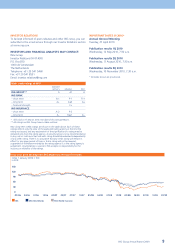ING Direct 2009 Annual Report Download - page 14
Download and view the complete annual report
Please find page 14 of the 2009 ING Direct annual report below. You can navigate through the pages in the report by either clicking on the pages listed below, or by using the keyword search tool below to find specific information within the annual report.
Company, we also worked closely with the Dutch authorities and
the European Commission (EC) to identify steps which would
enable ING to get the EC’s approval for the support received from
the Dutch State. This process was finalised in the second half of
2009 and is further explained below.
RESTRUCTURING PLAN SUBMITTED TO THE
EUROPEAN COMMISSION
Under European rules, state-supported companies need to
demonstrate their long-term viability and take actions to prevent
undue distortions of competition. As a result, parallel to the
introduction and implementation of the first phases of the Back
to Basics programme, we were required to develop and submit
a restructuring plan to the EC. Against this backdrop we had to
devise a plan that would not only enable us to pay back the Dutch
State and address the EC’s requirements, but also return our focus
to the business and our customers. This was a challenging exercise,
especially since the relevant EC guidelines were only published
in July 2009, which postdated ING’s transactions with the
Dutch State.
Our negotiations with the EC were finalised in October 2009. On
18 November, the EC formally approved the restructuring plan,
which ING had submitted. With this decision the EC also gave final
clearance for the issuance of the core Tier 1 securities to the Dutch
State and for the IABF. On 25 November 2009, the extraordinary
General Meeting approved the resulting strategic shift of the
Company, as well as the proposed rights issue of EUR 7.5 billion to
facilitate an early repayment of the Dutch State. The Restructuring
Plan’s strategic implications for ING are explained below.
As already explained, a key goal of the Back to Basics programme
was to reduce ING’s complexity by operating the Bank and Insurer
separately under the one Group umbrella. The negotiations with
the EC on the Restructuring Plan have thus acted as a catalyst to
accelerate this process, by completely separating our banking and
insurance operations, and ultimately eliminating our double
leverage. The backgrounds and objectives of this strategic shift are
further explained in the Strategy section (page 15).
ING has had to accept a number of commitments to obtain the
EC’s approval for the transactions with the Dutch State. One of
these involves the divestment of ING Direct US. It is anticipated that
this divestment will take several years and be completed before the
end of 2013. In the meantime, we will ensure that we continue to
grow the value of the business and invest in a superior customer
experience. We regard ING Direct US as a very strong franchise and
the US market clearly offers potential for growth. The concession
regarding ING Direct US has no impact on ING Direct in other
countries. We remain committed to the ING Direct franchise as a
strong contributor to our growth. Its unique customer proposition,
simple transparent products and market-leading efficiency are core
elements of our banking strategy.
Also as part of the Restructuring Plan, a new company will be
created in the Dutch retail market out of part of our current
operations, by combining the Interadvies banking division
(including WestlandUtrecht Hypotheekbank and the mortgage
activities of Nationale-Nederlanden) and the existing consumer
lending portfolio of ING Retail. This business, once separated, will
be divested. The combined business will be the number 5 financial
institution in the Netherlands. It is profitable and currently has a
balance sheet of EUR 37 billion, with around 200,000 mortgage
contracts, 320,000 consumer lending accounts, 500,000 savings
accounts and 76,000 securities contracts. The business has a
mortgage portfolio amounting to approximately EUR 34 billion,
which equates to a market share of around 6%.
Furthermore, ING must refrain from being a price leader within
the EU for certain retail and SME banking products, and must
refrain from acquisitions of financial institutions that might slow
down the repayment of the core Tier 1 securities. These restrictions
will apply for the shorter period of three years or until the core
Tier 1 securities have been repaid in full to the Dutch State.
ING had submitted the Restructuring Plan on the condition that the
EC guarantees equal treatment of all state-supported financial
institutions and safeguards the level playing field in the EU internal
market. In January 2010, ING lodged an appeal with the General
Court of the European Union against specific elements of the EC’s
decision of 18 November 2009. The first element involves ING and
the Dutch State’s agreement upon a reduction of the repayment
premium for the first EUR 5 billion tranche of core Tier 1 securities.
This agreement provided the Dutch State with an early repayment
and at an attractive return. The Commission views this reduction as
additional state aid of approximately EUR 2 billion. Both ING and
the Dutch State contest this element of the decision, as it could
hamper discussions between ING and the State on repayment
terms of the remaining core Tier 1 securities.
ING also seeks a ruling on the price leadership restrictions and the
proportionality of the restructuring requirements demanded by the
EC. ING believes it is in the interest of all its stakeholders to use the
opportunities provided by law to let the General Court review these
elements of the EC’s decision. The appeal does not alter ING’s
commitment to execute its Restructuring Plan as announced on
26 October 2009. ING stands firmly behind its strategic decision
to separate Banking and Insurance operations and divest the latter.
These processes are on track and will continue as planned.
The restructuring measures, including steps already taken as part
of our Back to Basics programme, are expected to result in a pro
forma balance sheet reduction of around EUR 600 billion by 2013,
approximately the equivalent of 45% of the balance sheet at
30 September 2008. This will be achieved through divestments
mentioned above and further deleveraging of the bank balance
sheet. Including estimated organic growth, it is expected that by
the end of 2013 our balance sheet will be approximately 30%
smaller than at 30 September 2008. The proceeds from divesting
the insurance operations will be used to eliminate double leverage
and further repay the Dutch State.
RIGHTS ISSUE AND ADDITIONAL AGREEMENTS
WITH THE DUTCH STATE
In conjunction with the Restructuring Plan submitted to the EC,
we also reached an agreement with the Dutch State to modify the
repayment terms of the core Tier 1 securities in order to facilitate
early repayment, bringing the terms in line with Dutch peers. We
thereby made use of an early repayment option to repurchase half
of the core Tier 1 securities before the end of January 2010. As a
ING and the financial environment (continued)
1.2 Report of the Executive Board
ING Group Annual Report 2009
12



